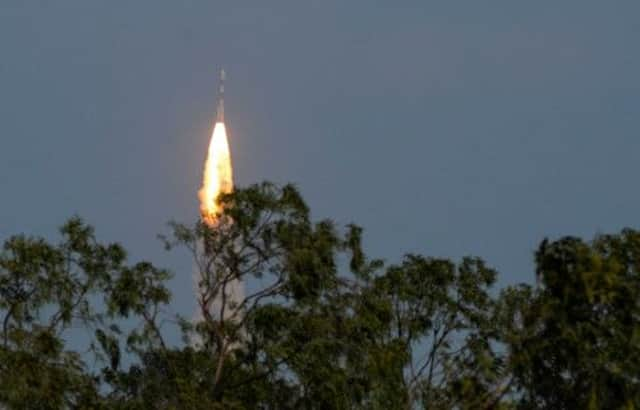India’s economy-class rocket to Mars


The Mars Orbiter Mission’s red and white striped rocket blasted off yesterday from the south-east coast, streaking across the sky in a blazing trail, and is scheduled to orbit Mars by next September.
Probes to Mars have a high failure rate and a success would be a boost for Indian national pride, especially after a similar mission by China failed to leave Earth’s orbit in 2011.
Advertisement
Hide AdAdvertisement
Hide AdOnly the United States, Europe, and Russia have sent probes that have orbited or landed on the planet.
“The ISRO team will fulfil the expectations that the nation has in them,” said K Radhakrishnan, head of the state-run Indian Space Research Organisation (ISRO), after the spacecraft was successfully placed into orbit. “The journey has only begun.”
India’s space programme began 50 years ago and developed rapidly after western powers imposed sanctions in response to a nuclear weapons test in 1974, spurring its scientists to build advanced rocket technology. Five years ago, its Chandrayaan satellite found evidence of water on the Moon.
India’s relative prowess in space contrasts with mixed results in the aerospace industry. State-run Hindustan Aeronautics has been developing a light combat aircraft since the early 1980s with no success so far.
“The point is we don’t have the sound technological base for a car, forget about a fighter jet,” said Rajeswari Pillai Rajagopalan, senior fellow at the Observer Research Foundation.
The mission plans to study the Martian surface and mineral composition as well as search the atmosphere for methane, the chemical strongly tied to life on Earth. Recent measurements by Nasa’s rover, Curiosity, show only trace amounts on Mars.
India’s space programme has drawn criticism in a nation is dogged by poverty and power shortages, and now experiencing its sharpest economic slowdown in a decade, but supporters say it can fuel technological advances in many sectors, from telecommunications to weather forecasting for disaster management.
The mission is considerably cheaper than some of India’s more lavish spending schemes, including a £212 million plan to build the world’s largest statue in the state of Gujarat.
Advertisement
Hide AdAdvertisement
Hide AdISRO designed the craft to go around Earth six or seven times to build up the momentum needed to slingshot it to Mars, a measure that will help it save fuel.
It costs India about 1,000 rupees (£10) to put a gram weight into space, less than a tenth of Nasa’s cost, Indian experts claim.
India’s space programme still has challenges, including the need to import components and the lack of a deep space monitoring system, which means it will rely on the United States to watch the satellite once it nears Mars.
Officials dismissed the suggestion that India raced to prepare yesterday’s launch to trump China’s failed attempt at Mars.
“We’re not in a race with anybody,” said ISRO spokesman Deviprasad Karnik.
Nazi swipe at Hindu nationalist
The Indian government has stepped up its criticism of leading opposition candidate Narendra Modi, painting him as a dangerous extremist whose rise is akin to that of the Nazis.
His critics have long sought to associate the Hindu nationalist with fascism and blame him for anti-Muslim riots in 2002 in Gujarat that killed at least 1,000 people. He denies any wrongdoing and a Supreme Court investigation found no evidence to prosecute him.
His Bharatiya Janata Party is polling well ahead of the Congress party in state elections starting next week and a general election expected by April.
Advertisement
Hide AdAdvertisement
Hide AdJairam Ramesh, a senior Congress cabinet minister, yesterday said Modi’s career reminded him of the rise of the Third Reich. “Political autocracy, social divisiveness and economic liberalism. That’s Mr Modi reduced to three dimensions. Exactly what created the autobahns and the Volkswagens in the 30s but also created the disaster of Germany. I would say we are going through what Germany went through in 1932.”